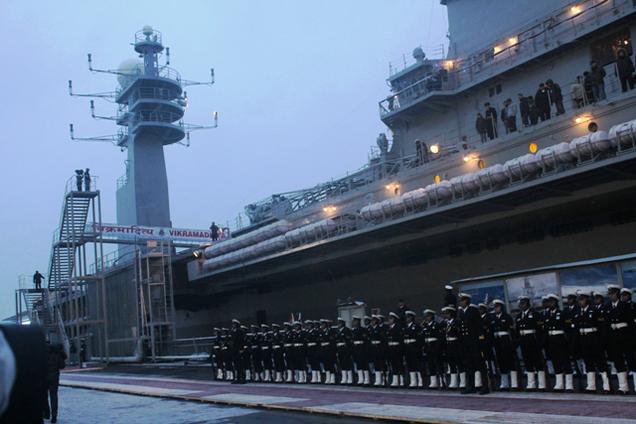Sevmash Shipyard (Russia), November 16: INS Vikramaditya, the refurbished Soviet-era aircraft carrier Admiral Gorshkov that caused many twists and turns in Indo-Russian relations, was inducted into the Indian Navy after a delay of over five years at a ceremony at the chilly northern Russian shipyard of Sevmash, at Severodvinsk, on Saturday.
“It is a red letter day in the history of India-Russia cooperation,” said Defence Minister A.K. Antony after unveiling the commissioning plaque aboard the 44,500 tonne carrier.
Top officials from India and Russia, including Russian Deputy Prime Minister Dmitry Rogozin, defence Minister Sergei Shoigu and Navy chiefs of both countries attended the splendid ceremony that was conducted on the flight deck of the carrier on a snowy, windy morning in sub-zero temperatures.
The induction of Vikramaditya brings the curtains down on a 13-year saga of carrier reconstruction marred by recurrent time slippages, cost overruns and edgy political negotiations. With this, the Navy has inched closer to its dream of concurrently operating three carrier battle groups.
As Chief of the Naval Staff Admiral D.K. Joshi said, it would bridge the time-gap between the retirement of the ageing carrier INS Viraat and the under-construction indigenous carrier INS Vikrant. INS Vikramaditya will have the MiG-29 K fighter, of which India has already inducted 20 of the 45 on order, besides Kamov-31 helicopters, as part of its integral fleet. The carrier can also support operations of Sea Harrier jump jets, Chetak search and rescue helicopters, Seaking anti-submarine warfare helicopters and the indigenous Advanced Light Helicopter (ALH) Dhruv, which will conduct night-flying operations from its deck at its homeport at Karwar in Karnataka, where it will reach in January next.
Mr. Antony said India’s relationship with Russia remained a matter of highest priority for mutual benefits and as a factor of global peace and stability. Terming the carrier as adding a whole new dimension to the operational capabilities of the Indian Navy, he said the event realised the vision of capability-based transformation of the Navy which was conceived over a decade ago.
“India’s economic development is dependent on the seas and safeguarding the nation’s maritime interests is central to our national policy. Aircraft carriers have been part of the Indian Navy’s force structure since our independence and have effectively served the country over the past five decades or so,” he said. Mr. Rogozin saw the carrier as symbolising close ties between both nations and hoped it would grow in the days to come.
Admiral Joshi viewed the induction as catalysing the India-Russia strategic partnership to greater heights. On the need for a three-carrier Navy, he said given India’s vast seascape, far-flung islands, regional geopolitics and the dynamic maritime security environment, aircraft carriers were necessary to implement India’s strategic interest in the region. The transformation of a Heavy Aircraft Carrier Cruiser into a modern short-take off but arrested recovery (STOBAR) air defence platform was challenging for both nations, he said.
On Saturday morning, the dignitaries were given a ceremonial Guard of Honour by Indian and Russian naval personnel. The Russian flag on the modernised vessel was lowered. Soon after Captain (Commodore) Suraj Berry, Vikramaditya’s commanding officer, read out the commissioning order, Indian tricolour was hoisted on the vessel with a 34-men colour guard led by Lieutenant Commander H. Mehta in attendance. The naval band rendered the national anthem.
The aircraft carrier will set sail for India by the end of November or early December.

